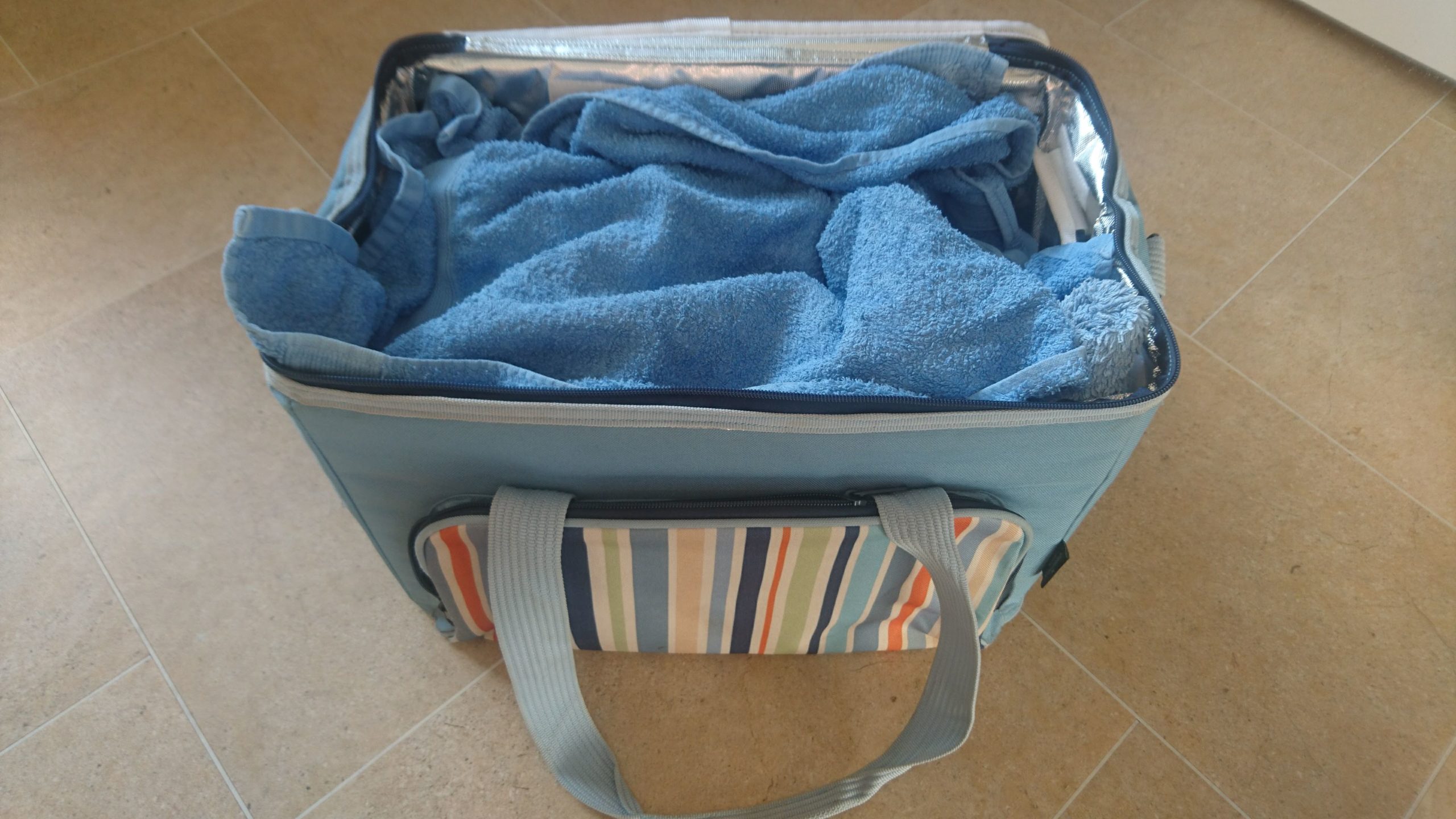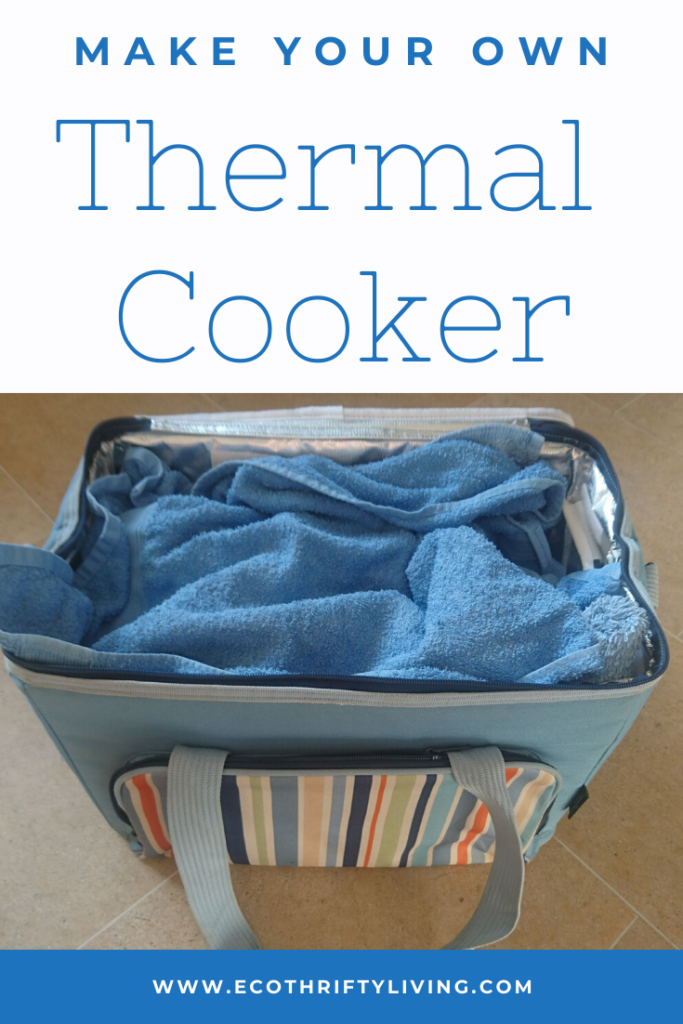
Make your own thermal cooker
Why slow cook food?
Thermal cookers are great for saving energy, time and money. I batch cook soup and stews and slow cooking brings out lots of the lovely flavours. Slow cooking can help you to get organised, just throw all the ingredients in to come back later to a delicious meal. Slow cooking can also tenderize tough cuts of meat (if you are a meat eater)
This blog post contains an affiliate link marked with * and anything you buy through them will help to support the blog. All opinions are my own and it won’t cost you anything extra to use the links.
You don’t need to buy a thermal cooker. It is easy to make an improvised one, with what you already have at home.
A while ago I decided to experiment with DIY thermal slow cookers, or heat retention cookers as they are also known. There are loads of types of them, the most famous being the hay box – literally a box filled with hay or sometimes a hole in the ground. I didn’t want to make a hay box, so had a look around to see what I could use.
What’s the difference between a slow cooker and a thermal cooker?
- A slow cooker needs electricity. A thermal cooker has no power.
- A slow cooker can keep a steady temperature
- A thermal cooker retains its own heat and will cool down over time
- You can put raw food into a slow cooker
- Food needs to be cooked / boiled before going into the thermal cooker
My DIY slow cooker experiment
I experimented with using two freezer bags and two towels to slow cook veg stock. This was my method:
- I brought a pan of veg peelings, herbs and water to the boil and then took it off the heat.
- Next I wrapped the pan up in a towel.
- I placed the pan inside a freezer bag.
- I zipped it up and put the freezer bag inside a larger freezer bag.
- Finally I put another towel in the second freezer bag to fill up the gap and then zipped it up.
- I left it there for 8 hours
The towel around the pan was damp, when I took the stock out. The stock was luke warm and it didn’t taste that great. I now realise that I made a couple of mistakes (and I probably shouldn’t have tasted that veg stock).
Things to avoid when making a thermal cooker:
- I used a glass saucepan, but the lid wasn’t particularly tight fitting. Glass doesn’t retain the heat well enough and even a glass lid on a saucepan is not a good idea for heat retention.
- Follow a recipe. Despite clear instructions from Jen Gale on including apple peelings in the stock mixture, I didn’t add any.
- I made the mistake of putting a hot pan in a insulated bag and melting the plastic! Wrap the hot pan in a towel before putting it in the freezer bag and put a trivet underneath the pan at the bottom of the bag.
- Don’t use your best bath towel for this, use one that has been well used and it may get dirty.
If you want to make a heat retention cooker with stuff you already have here are some tips:
- Make sure you have an appropriate pan. A stainless steel pan with a stainless steel tight fitting lid is best.
- Find a freezer bag which leaves as little room for air or heat to escape as possible.
- Fill the bag with insulating material, like old wool jumpers, towels or cushions. Choose something that traps air well and make sure there is still space for your pan.
- The bag should be a close fit to the pan.
- Make sure the pan is as full as possible with boiling liquid. This helps retain the heat.
- Follow a recipe designed for a thermal cooker.
- Put the hot pan on a trivet in the freezer bag and line the bag with towels. This avoids the bottom and sides of the bag melting.
- Cover the pan with towels to not melt the bag.
- Leave as few gaps in the outer bag as possible for air and heat to escape through.
- Fill all the available space between the pot and the outer bag with insulating material.
If you don’t have freezer bags to hand you can use your oven as a replacement thermal cooker. I have used this method to make yoghurt after my thermos broke.
After experimenting with thermal and retention cookers I now have a Wonderbag* – which is a thermal cooker bag and I love it. This particular company has a really nice ethos behind it. You can read about my experience with my Wonderbag here: The Wonderous Wonderbag*ad*.






Hi Look at http://www.iwillprepare.com/cooking_files/Wonder_Box.htm there is a pattern to make a wonder bag plus recipes
Thanks for the tip Chris!
I've been cooking peppers and onions in the skillet on the grill a lot lately. I'll have to add jalapenos next time. Yum. I like cooking bacon that way too, although hot fat + open flame adds a nice element of danger. I used to get flank steak, but my husband got me to try the carne asada cut from our local market, and I prefer it. Not sure if it's thin-cut flank or skirt (I'll have to ask), but it looks like this
“I filled up the pan with as much boiling water as possible which is meant to be important (I think it helps retain the heat better).”
What it does is provide more thermal mass and thus more energy to cook.
The heavier the pan the better for the same reason. Something like a dutch oven works well..you can use plastic wrap to moisture seal the lid.
The more dry material you can put around and over the pot the better.